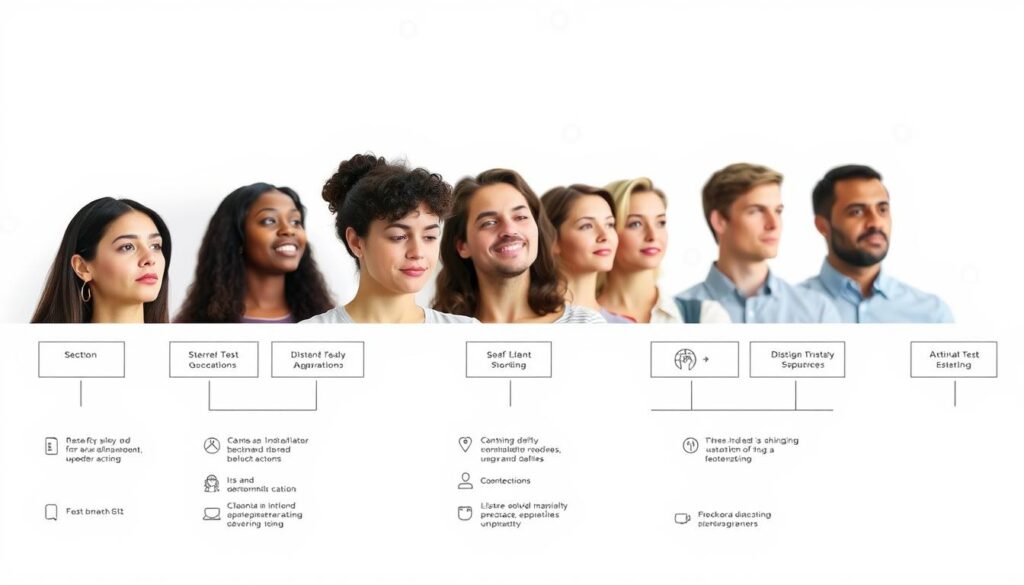Are you preparing for the IELTS exam and looking to improve your listening skills? The IELTS Listening test can be challenging, but with the right strategies, you can achieve a high score. This guide provides a detailed breakdown of the test format, essential techniques, and advanced tips to help you excel.
The IELTS Listening test lasts 40 minutes, including 30 minutes of audio and 10 minutes to transfer your answers. You’ll encounter various question types, such as multiple choice, matching, and short answers. Managing your time effectively is crucial, as you only hear each section once.
Practice is key to improving your listening skills. Regular practice with authentic materials can significantly enhance your comprehension. Additionally, familiarizing yourself with different accents and note-taking strategies can help you avoid common mistakes and perform better on test day.
This guide is designed to be accessible and friendly, offering step-by-step advice and real-life examples. Whether you’re taking the paper-based or computer-based test, you’ll find valuable insights to boost your confidence and performance.
Key Takeaways
- Understand the test format and question types to better prepare.
- Effective time management is essential for success.
- Regular practice with authentic materials can improve comprehension.
- Note-taking and avoiding mistakes are vital strategies.
- Familiarize yourself with different accents to enhance understanding.
For more detailed strategies and resources, visit our IELTS preparation guide to maximize your test performance.
Understanding the IELTS Listening Test Format
The IELTS Listening test is divided into four distinct parts, each designed to assess different skills. The total duration is 40 minutes, with 30 minutes of audio and 10 minutes to transfer answers. This structure is consistent across both paper-based and computer-based tests.
Test Structure and Timing
Each section of the test features recordings that vary in context and speaker numbers. For instance, the first section is a conversation between two people in a everyday setting, while the second is a monologue on a social topic. Sections three and four involve group discussions and academic monologues, respectively.
Timing is crucial. You have only one chance to listen to each recording, so staying focused is key. After the audio ends, you have a short time to review your answers before moving to the next section.
Key Question Types and Sections
The test includes various question types such as multiple choice, matching, and form completion. These questions are designed to evaluate your ability to capture specific details and overall ideas. Understanding each question type can help you approach the test more effectively.
Multitasking is essential during the test, as you need to listen, read, and write simultaneously. This skill can be developed through consistent practice. Familiarizing yourself with diverse accents and improving note-taking strategies are also vital for success.
Knowing the test format helps reduce anxiety and improves performance. By understanding the structure and timing, you can formulate a preparation strategy that targets your weaknesses and strengthens your skills.
Essential Tips for IELTS Listening Success
Mastering the IELTS Listening test requires more than just hearing words. It demands focus, strategy, and smart techniques to tackle the challenges of a one-time listening opportunity.
Strategies for Managing the One-Time Listening Challenge
One of the biggest hurdles in the IELTS Listening test is that the audio is played only once. To overcome this, underline keywords in the questions as you read them. This helps you stay focused and quickly identify relevant information as it’s spoken. For example, if a question asks about a specific date or location, highlighting those key terms will guide your listening.
Techniques to Avoid Common Pitfalls
Common mistakes include mishearing similar-sounding words or losing focus during complex discussions. To avoid these, stay calm and avoid translating. Concentrate on capturing main ideas and specific details rather than every single word. This approach will help you maintain accuracy and composure.
| Strategy | Benefits |
|---|---|
| Underline Keywords | Improves focus and quick identification of key information. |
| Avoid Translating | Enhances comprehension by focusing on main ideas. |
| Practice with Scripts | Builds familiarity with accents and question formats. |
Optimizing Answer Transfer and Checking Time
Use the 10-minute transfer time wisely. Review your answers for spelling and grammar errors, as these can cost you points. For digital tests, ensure you’re typing accurately and quickly. Practicing full-length tests under timed conditions will help you master this critical step.
For more tips and resources, visit our IELTS Listening preparation guide to enhance your test performance.
How to Practice IELTS Listening Effectively
Effective preparation is key to achieving a high score in the IELTS Listening test. By using the right strategies and materials, candidates can significantly improve their skills and confidence.
Utilizing Authentic Materials and Practice Tests
One of the most effective ways to prepare is by using authentic IELTS materials. These resources closely mirror the actual exam experience, helping you get used to the types of questions and audio formats you’ll encounter. Practice tests are especially valuable because they allow you to simulate real test conditions. For example, you can practice full listening sections without pausing the recording, which helps build stamina and focus.
Linking Keywords to Answer Strategies
During practice, pay close attention to keywords in the questions. These keywords often signal the type of information you need to listen for. For instance, if a question asks about a specific date or location, underline those terms to stay focused. This strategy helps you quickly identify relevant details as they are spoken. Over time, this approach becomes second nature, improving both speed and accuracy.
After each practice session, review the transcripts to identify and correct mistakes. This step is crucial for understanding where you went wrong and how to avoid similar errors in the future. Self-analysis and targeted practice are powerful tools for developing robust listening skills.
Finally, explore various platforms and resources that offer IELTS listening practice and video lessons. These tools provide diverse accents and question formats, helping you refine your techniques and eliminate mistakes. By focusing on these strategies, you’ll be well-prepared to achieve your desired score and excel in the exam.
Advanced Strategies to Maximize Your Score
Elevate your IELTS Listening performance with advanced techniques designed to refine your skills and boost your confidence. These strategies go beyond basic preparation, helping you tackle even the toughest challenges with ease.
Developing Note-Taking and Multitasking Skills
Effective note-taking is crucial during the test. Focus on capturing key details quickly by underlining important words and phrases. This helps you stay focused and quickly identify relevant information as it’s spoken. For instance, if a question asks about a specific date, highlighting that term will guide your listening.
Multitasking is another essential skill. You’ll need to listen, read, and write simultaneously. Practice this by taking timed exercises that simulate real test conditions. This will help you build stamina and maintain focus without losing track of the task at hand.
Building Vocabulary and Recognizing Diverse Accents
Expanding your vocabulary enhances your ability to recognize synonyms and understand paraphrased answers. Regular exposure to various accents, such as British or Australian, can also improve comprehension. For example, a student who familiarized herself with different accents noticed a significant improvement in her ability to grasp complex discussions.
Targeted practice, such as listening to diverse accents and completing timed exercises, can significantly impact your final score. By staying disciplined and aware of subtle differences in accents, you can refine your listening skills and achieve the results you desire.
Conclusion
Mastering the IELTS Listening test requires careful preparation, consistent practice, and a deep understanding of the test format. By focusing on key strategies like managing the one-time listening challenge and optimizing answer transfer, you can significantly improve your results. Regular practice with authentic materials helps build familiarity with diverse accents and question formats, while reviewing mistakes ensures targeted improvement.
Advanced techniques, such as effective note-taking and multitasking, are essential for tackling complex discussions and avoiding common pitfalls. Remember, consistent practice and attention to detail are key to achieving a high score. Explore additional resources, such as downloadable answer sheets and video lessons, to further enhance your preparation. With dedication and the right approach, you’ll be well-prepared to excel in the exam and achieve your desired outcome.
FAQ
What is the best way to manage time during the IELTS Listening test?
Time management is crucial. Allocate a few seconds to read each question before the recording starts. Focus on key words and phrases that match the question type. Use the 30-second gap after each section to review your answers quickly.
How can I improve my ability to catch specific information?
Train your ears to pick up specific details like numbers, dates, and names. Practice with short audio clips at home, focusing on extracting one-word answers or short phrases. This skill is essential for multiple-choice and gap-fill questions.
What if I encounter unfamiliar vocabulary during the test?
Don’t panic. Use context clues to guess the meaning. Often, the answer lies near the unfamiliar word. If you’re stuck, move on and return later to avoid wasting time.
Can I transfer answers after the recording ends?
Yes, you have 10 minutes to transfer your answers to the answer sheet. Use this time wisely to double-check spelling and ensure all answers fit the required format, especially for tables or flowcharts.
How can I avoid losing marks due to spelling mistakes?
Pay close attention to spelling when transferring answers. Practice writing under time pressure during mock tests. If unsure about a word’s spelling, try to paraphrase or use synonyms if possible.
Is it necessary to take a practice test at home?
Absolutely. Simulate real test conditions at home to build familiarity with the format and timing. Use authentic materials or past papers to gauge your progress and identify weak areas.
How can I handle different accents in the recording?
Exposure is key. Listen to a variety of accents regularly, such as British, American, Australian, and others. This will help you recognize words more easily during the test.
What is the most common mistake candidates make?
One of the most common errors is misreading the question type or format. Always double-check if the question requires a one-word answer, multiple choices, or a table completion.
Can I retake the test if I’m unhappy with my score?
Yes, you can retake the test as many times as needed. Use your previous results to identify areas for improvement and focus your preparation on those sections.
How long does it take to see results after the exam?
Results are typically available 13 days after the test date for computer-based exams and up to 28 days for paper-based exams. Check your test center for exact timelines.






